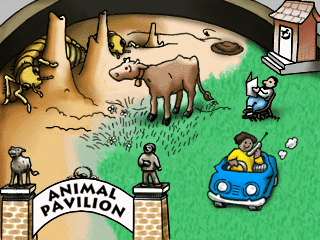

Humans | Cow Rumen | Termite | Poo Corner


Humans | Cow Rumen | Termite | Poo Corner
Animals provide microbes with food and shelter. You could say that animals throw a continuous party for microbes. That is why animals are called "hosts" to microbes. Often when people think about microbes and animals, they think of disease. However, most microbes do animals more good than harm. Since we can't see them when they are being good, we only notice when microbes go bad and cause disease. Here is your chance to see how microbes assist us and other animals.
Habitat on Humanity
The right microbes on our skin and in our guts keep us humans healthy.
Cow Rumen
Humans depend on cows for milk and meat. Find out how cows depend on microbes for their food. Cows and other animals called ruminants have special stomachs called rumens which are host to billions of microbes that help these animals survive.
Termite Gut
You probably thought termites digested wood. They don't, but the microbes that live inside their guts do. By digesting wood bits, the bacteria and protists in the termite's guts help the termites survive. In turn, the termite gives the microbes a comfy place to stay.
Poo Corner
One product of all animals is dung. Without microbes to get rid of all the dung, the world would be a really poopy place. Check out Poo Corner to see the microbes that make this world a cleaner place.
© 1999 Comm Tech Lab, Michigan State University. This work was created with support from the National Science Foundation and the Center for Microbial Ecology at Michigan State University.